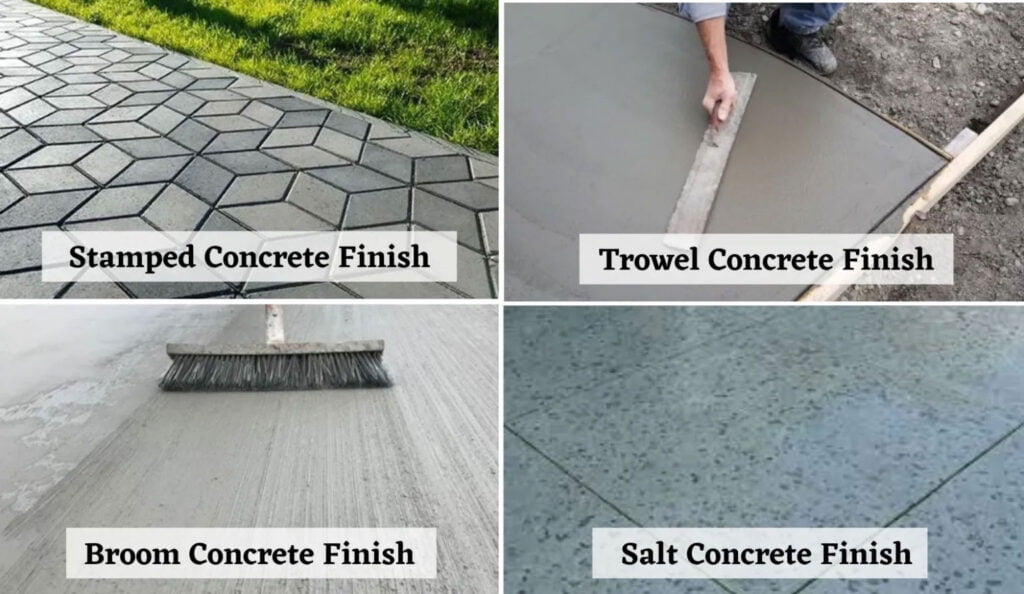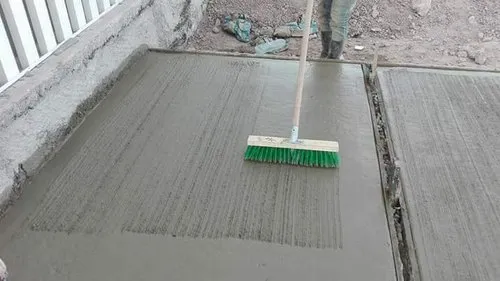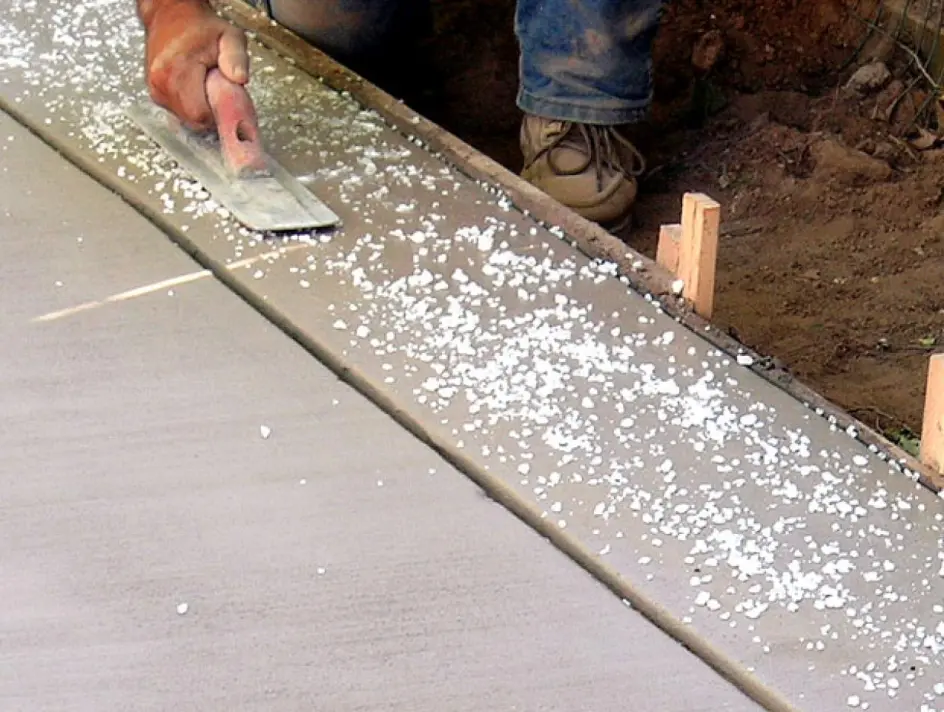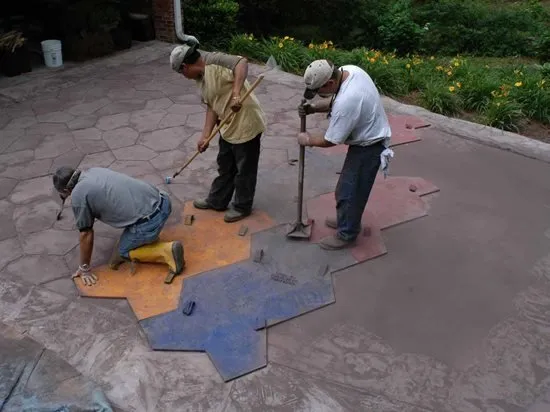Table of Contents
What Is Concrete Finishes?
The most basic forms of concrete finishes are smooth surfaces created using screeds and trowels. Work screed is used to level the concrete surface after it has been poured into the form. Screeds are long metal or wood pieces that are dragged and pushed across the concrete surface to remove excess concrete and fill in gaps.


Concrete is a versatile building material used in a variety of residential, commercial, and industrial applications all over the world. The strength of concrete is found on the inside, while its beauty is found on the exterior.
As seen below, a number of materials and techniques may be used to change the outer appearance.
9 Types of Concrete Finishes
The following are different concrete finishes types,
1. Floating or Troweling
After the concrete has been tooled using a screed, concrete finishers use trowels to smooth and fine–level the surface. Manual or mechanical means can be used to accomplish this.
When manual trowels aren’t viable, power trowels are widely used on big commercial and industrial projects. Power trowel blades resemble large fans and rest right against the concrete. These motorized trowels come in both walk–behind and riding versions.
2. Broom Concrete Finishes
To make concrete surfaces more slip-resistant, employ a broom finish. After the concrete has been put, leveled, and troweled, this is done.


After the concrete has been leveled, a brush is dragged across the surface to create small ridges that provide traction control, especially when the concrete is wet. Liquids on concrete surfaces that do not have a broom finish become slippery and dangerous.
3. Exposed Aggregate Finish
The edges of the natural stone aggregates poured into the concrete are revealed when the top layer of concrete is washed away, providing an exposed finish that was previously prevalent on old city sidewalks. As a result, the coating is both visually pleasing and slip-resistant. Other materials, in addition to the typical concrete elements (cement, sand, gravel, and water), can be added to the mix to create distinctive exposed concrete finishes.
Some examples are rose quartz, limestone, dark grey or black basalt, red or blue granite, colored glass, and even seashells. Stay away from iron-containing materials while using any of these compounds, as they might discolor concrete. After the concrete has been set, it’s also critical to apply a high–quality seal to preserve the surface. The concrete surface after the exposed aggregate treatment is seen below.
4. Salt Finish
A salt finish is a type of finish commonly found on pool surfaces. Salt concrete finishes are created by sprinkling rock salt on wet concrete and then washing it away, leaving pits in the finished result.


The salt finish is created by rolling coarse rock salt crystals over a freshly built concrete surface and then washing it off with streams of water once it has solidified.
This coating gives plain or colored concrete a lovely, subtle texture and provides skid resistance. Swimming pools and other moist settings are its primary use.
5. Stamped Concrete
Concrete stamps are a popular textural option. Panels with inlaid designs are put on still-curing concrete to create concrete stamps. Designs may incorporate brick, stone, or other ornamental patterns to produce the desired appearance, often emulating other common construction materials while maintaining the strength and durability of concrete.


Following the removal of the forms, the concrete surface can be tinted to add color, as seen below. The stamped concrete finish is created by pressing the required patterns into freshly leveled concrete. This kind of concrete finishes mimics slates or flagstones, brick, tile, or, with the appropriate ability, wood when construction is completed.
Stamped concrete is a creative and imaginative concrete invention that works well for patios, car porches, driveways, and pathways.
6. Coloration of Concrete Finishes
Concrete is colored to complement the architecture of the surrounding structure. This can be accomplished using mix-added pigments or post-cure staining, both of which are described below. The colorful finish of the concrete is produced using mix-added pigments or post-cure staining to provide a pleasant aesthetic that suits the surrounding surroundings.
A colorful finish on a concrete surface can be achieved using pigment or stress. Pigment-colored concrete may be manufactured by putting pigments directly into the concrete mix before pouring. To obtain a more dramatic colored finish, stains can be put to the concrete of any age, resulting in strained colored concrete. A sealer is frequently used after the stain has been applied to preserve the concrete surface.
7. Pigments Concrete Finishes
Color concrete using pigments is a simple process that includes putting the pigments directly into the concrete mix prior to pouring. Pigments are available in liquid form or as “ready to mix” dissolvable sachets. The pigments are mixed with the other concrete elements in the mixer in both cases.
Greens, blues, and greys are also available. The color range is normally confined to “earthy” browns and tans, although greens, blues, and greys are also available. To minimize water intrusion, which can fade the color, it’s vital to keep pigmented concrete well-sealed throughout its lifespan.
8. Concrete Stain
Various staining chemicals can be used to affect the color of concrete. The use of acid as a staining agent is very common. Colors are frequently confined to neon-bright, delicate tones, comparable to those found in concrete paints.
Water–based (acrylic) staining allows for a far broader variety of colors, including black and white. Stains may be placed on any age of concrete, however, the colors are normally more vibrant if applied immediately after the concrete is laid. A sealer is frequently used after the stain has been applied to preserve the concrete surface.
FAQs:
What do you mean by Concrete finishes?
The most basic type of concrete finish is a smooth surface created with screeds and trowels. A screed is used by concrete finishers to level the concrete surface after it has been set in form.
What is the Colouration of Concrete?
Concrete is colored to complement the architecture of the surrounding structure. This can be accomplished using mix-added pigments or post-cure staining, both of which are described below.